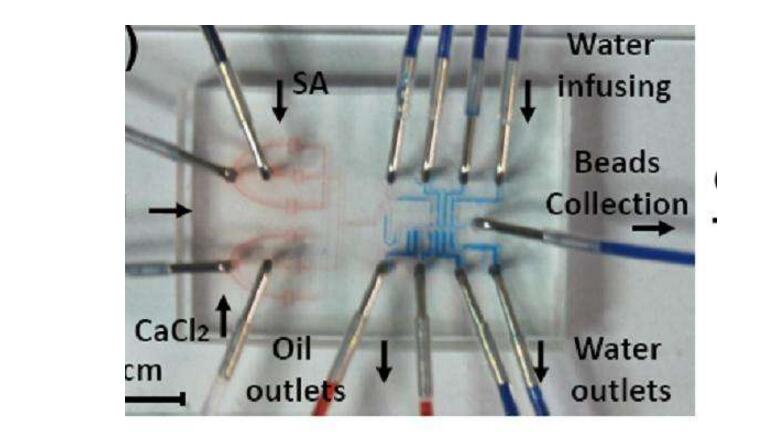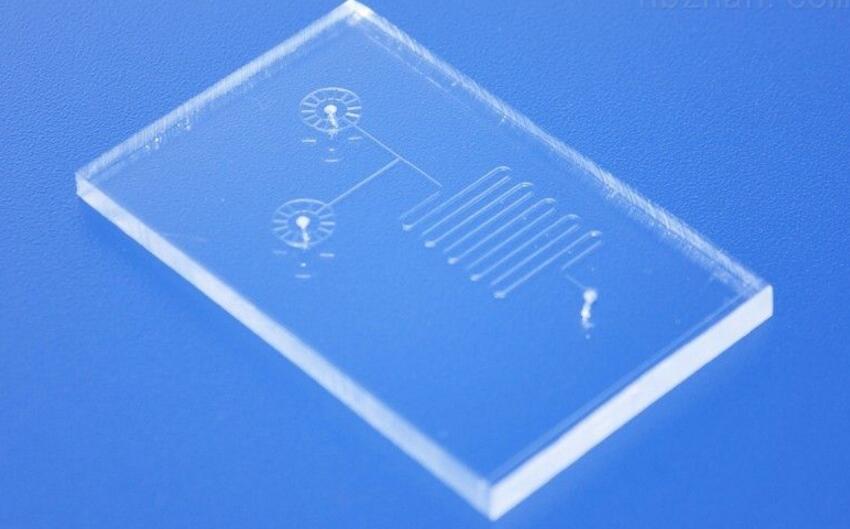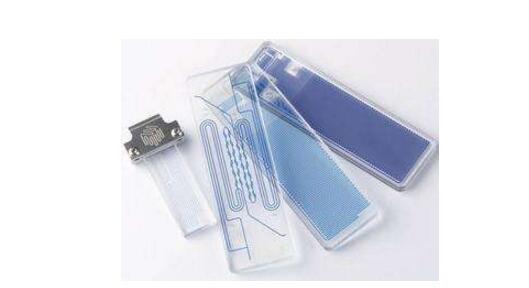The microfluidic technology can concentrate the multiple steps of sample detection on a small chip, integrate these operating steps through the combination of the size and curvature of the flow channel, microvalve, and cavity design, and ultimately make the whole Test integration miniaturization and automation.
(B) High throughputSince the microfluidic device can be designed to be a multi-channel, the sample to be detected can be distributed to multiple reaction units at the same time through the micro-channel network, and the reaction units are isolated from each other so that each reaction does not interfere with each other. Therefore, it is possible to Multiple items were tested in parallel with the same sample. Compared with the conventional test-by-item detection, the time of detection is greatly shortened, the detection efficiency is improved, and the characteristics of high throughput are achieved.
(III) Less consumption of test reagentsDue to the miniaturization of the integrated detection, the cavity of the reaction unit on the microfluidic chip is very small. Although the concentration of the reagent formulation may be increased in a certain proportion, the amount of the reagent used is far lower than the conventional reagent, which greatly reduces the reagent consumption. the amount.
(4) Low sample sizeSince testing is done on a small chip only, the amount of sample that needs to be detected is very small and often requires only microliters or even nanoliters. In addition, whole blood can also be directly used for detection. For infants, the elderly, and the disabled, those with low blood volume and difficulties in vein collection make it more convenient to detect; or it is a precious and scarce sample that makes it possible to detect multiple indicators. .
(five) less pollutionDue to the integrated function of the microfluidic chip, all operations that were originally required to be manually completed in the laboratory are all integrated on the chip and are automatically completed, so that the contamination of the sample to the environment during manual operation is minimized. For example, in the detection of molecular nucleic acids, whether it is the sample itself or the nucleic acid prepared for detection after preparation, it will cause pollution to the laboratory. The diffusion of aerosols will make false positives in subsequent samples. This is why conventional molecular nucleic acid detection requires different operations in at least 3 rooms. The use of microfluidic technology solves this problem.
It is precisely because of the above several important advantages and advantages of microfluidics, making it the first choice for POCT. And we judge whether such products have the demand and competitiveness in the market, and can judge from these aspects.

A mature microfluidic product often requires complementary reagents, a core microfluidic chip, a chip-driven platform, a photoelectric detection module, a signal processing module, and a human-computer interaction software system. For a mature industry chain, the different components of a complex product are produced on a large scale by different companies, and then assembled by a company that has mastered one or several core technologies. The most typical representative here is a smart phone. Funds such as Apple Inc. have no way to take all of the components such as CPUs, memory, screens, etc. in their own hands. However, in the industrialization of microfluidics, due to this technology is not yet mature, the products lack the corresponding standardization and standardization. At present, there is no way to realize the generalization of components. In this way, it will not be possible to form a collaborative product development model for upstream and downstream companies. The microfluidic products themselves are new products combining many fields such as micro-electromechanical processing, life science, chemical synthesis, optical engineering and electronic engineering. The technical requirements are high and the development cycle is long. This has also led to breakthrough products such as the GeneXpert PCR analyzer, which have not been able to achieve real profitability due to the high cost of research and development.
(II) Serious shortage of related talentsThere is a serious shortage of multidisciplinary talents, corporate R&D personnel, and specialized market personnel; domestic chip professionals, especially those engaged in product development, are extremely scarce.
(C) The current high production costsFor the microfluidic immunoassay chip, the biggest problem it faces is that the analysis chips are used once, which can not give full play to the advantage that the microfluidic analysis platform can be used multiple times, leading to increased detection costs under current processing conditions. A standard glass chip for research may be worth tens to hundreds of dollars.
(d) Problems of the technology platformSuch as the fixation of antibodies. Heterogeneous immunoassay is the immobilization of an antigen or antibody on the surface of a solid support, and the antigen or antibody is bound to the surface of a solid support to form an antigen-antibody complex through a specific immune reaction, and the antigen can be realized by simple cleaning. Isolation of antibody complexes from free antigen antibodies. Therefore, how to immobilize the antibody on the surface of the microchannel becomes a key problem for the heterogeneous microfluidic immunoassay chip. There are many ways to immobilize antibodies on the channel surface, including the direct adsorption of antibodies on the channel walls, the formation of covalently bound active functional groups on the basal surface, and microcontact printing. Biomolecules such as antibodies can be directly adsorbed on the surface of hydrophobic microchannels through hydrophobic interactions, but they may cause changes in the conformation of the antibody, resulting in reduced activity. At the same time, the closure of the microchannel surface is very important. By blocking the non-specific binding of restricted proteins and small molecules, these non-specific binding can affect the efficiency of the analysis. The non-specific binding of proteins and denaturation of antibodies greatly reduce the sensitivity of immunoassays. Therefore, it is very important for the microfluidic immunoassay chip system to cross-link antibodies with reasonable methods.
In addition, the integration of microfluidic chips and peripheral devices, such as automatic analysis and display devices, is also a major challenge. Microfluidic chips are science and technology destined to be deeply industrialized. This judgment is of course first of all due to the irreversibility of demand, intensified demand, and accelerated progress. On the other hand, it is based on the recognition of this irreplaceability of science and technology in some major areas. This recognition is only the most recent. It was only gradually accepted by people within a thousand years. It is likely to develop into a model of today's industrial transformation and will have an important impact on the new economy represented by bio-economy. For example, in the next few years, if the microfluidic chip is further integrated with "biological mobile phones" and "Internet Plus," whether such a trend triggered by an emerging technology may have a global influence can result in the birth of a batch of "windfalls." The industry is worth everyone to look forward to.

advantage:
· Has good chemical inertness and thermal stability
·Good finish, mature processing technology
·Moulds that can be used to make polymer chips, etc. (Wenpo Co., Ltd. provides silicon injection molds, PDMS injection molds, and other chip injection molds)
Disadvantages:
·Fragile, expensive
Can not pass ultraviolet light
· The electrical insulation performance is not good enough
·Surface chemistry is more complex
2, glass quartz materialadvantage:
Excellent electroosmotic and optical properties
· Facilitates chemical modification of the surface
· Can be processed with photolithography and etching techniques
Disadvantages:
It is difficult to obtain a channel with a large aspect ratio
High processing costs
·Difficult to seal
3, organic high polymer materials (PMMA, etc.)advantage:
Low cost, variety, low price suitable for mass production
·Can pass visible light and ultraviolet light
· Chemically modified surface
·Easy processing to obtain wide channel ratio
Disadvantages:
·Not high temperature
Low thermal conductivity
·The surface modification method is not mature enough
4, paper chip materialadvantage:
·Compared with silicon, glass and other materials, the cost of paper is low
· No template, no structural design
·The analysis system is easy to miniaturize and portable. No need for external drive pump, paper foldable, easy to save and transport
· Good biocompatibility. The main cost of filter paper is cellulose, which can immobilize biological macromolecules such as enzymes, proteins and DNA.
• The detection background is low. Paper is usually white, which facilitates colorimetric analysis on paper chips
·Simple post-processing, no pollution, easy and safe combustion
Disadvantages:
• Samples remaining in the paper path and evaporation of the sample during transport result in reduced sample utilization.
• For some samples with low surface tension, the hydrophobic region may not be sufficiently hydrophobic and the sample may leak.
• Combining traditional colorimetric methods, paper chips that are too low in concentration can not be detected.

1 There should be good chemical and biocompatibility between the chip material and the working medium of the chip lab, and no reaction occurs;
2 chip material should have good electrical insulation and heat dissipation;
3 chip material should have good modifiable, can produce electroosmotic flow or immobilization of biological macromolecules;
4 chip material should have good optical performance, little or no interference to the detection signal;
5 The production process of the chip is simple, and the materials and production costs are low.
Could you share which points you care more when choose a teacher laptop? Size, cpu, storage, memory, battery, screen, fingerprint or backlight? As one of the top laptops for teachers in 2022, this 15.6 inch celeron N5095 or J4125 online teaching laptop is of the special necessary features a laptop for online teaching has. For example, high quality 1080P screen, bigger battery, updated storage and memory, mid-level cpu, etc. So many clients choose this model as laptop for teachers malaysia or laptops for teachers program.
Of course, there are other type Education Laptop, like 14 inch windows 10 64 gb Student Laptop, 15 inch 10th good laptops for university students, 16.1 inch i7 9th hq 4gb video graphic laptop, etc.
If you have other type device interest, just let us know since we also customize android or windows tablet, Mini PC and All In One PC.
Believe always have a right one meeting your special demand, no matter for student project, business tender, academic institution or reselling.
Teacher Laptop,Online Teaching Laptop,Top Laptops For Teachers,Laptop For Teachers Malaysia,Laptops For Teachers Program
Henan Shuyi Electronics Co., Ltd. , https://www.shuyitablet.com